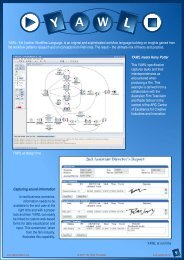YAWL - User Manual - Polytechnic of Namibia - Mirrors
YAWL - User Manual - Polytechnic of Namibia - Mirrors
YAWL - User Manual - Polytechnic of Namibia - Mirrors
You also want an ePaper? Increase the reach of your titles
YUMPU automatically turns print PDFs into web optimized ePapers that Google loves.
10 CHAPTER 1. INTRODUCTION• Through the BPMN2<strong>YAWL</strong> component, BPMN models can be mapped to the <strong>YAWL</strong> environment forexecution.• The Declare component (released through declare.sf.net) provides unique support for specifyingworkflows in terms <strong>of</strong> constraints. This approach can be combined with the Worklet approach thusproviding very powerful flexibility support.• <strong>YAWL</strong>’s architecture is Service-oriented and hence one can replace existing components with one’sown or extend the environment with newly developed components.• The <strong>YAWL</strong> environments supports the automated generation <strong>of</strong> forms. This is particularly useful forrapid prototyping purposes.• Tasks in <strong>YAWL</strong> can be mapped to human participants, Web Services, external applications or to Javaclasses.• Through the C-<strong>YAWL</strong> approach a theory has been developed for the configuration <strong>of</strong> <strong>YAWL</strong> models.For more information on process configuration visit www.processconfiguration.com.• Simulation support is <strong>of</strong>fered through a link with the ProM (www.processmining.org) environment.Through this environment it is also possible to conduct post-execution analysis <strong>of</strong> <strong>YAWL</strong> processes(e.g. in order to identify bottlenecks).1.2 Obtaining the Latest Version <strong>of</strong> <strong>YAWL</strong>As new versions <strong>of</strong> the <strong>YAWL</strong> Environment are released to the public, they will be available for downloadat the <strong>YAWL</strong> Sourceforge website (sourceforge.net/projects/yawl). From this site it is also possibleto access the source code <strong>of</strong> all components for development purposes.1.3 The <strong>YAWL</strong> FoundationFor up-to-the-minute information on any aspect <strong>of</strong> the <strong>YAWL</strong> Initiative, visit the <strong>YAWL</strong> Foundation Homepage(yawlfoundation.org). The <strong>YAWL</strong> Foundation is a non-pr<strong>of</strong>it organisation that acts as custodian<strong>of</strong> all intellectual property (IP) related to <strong>YAWL</strong> and its support environment.1.4 DocumentationApart from this user manual, there is a technical manual on <strong>YAWL</strong> and a number <strong>of</strong> case studies. Thesestudies provide detailed examples that you may wish to consult in order to obtain a deeper understanding<strong>of</strong> the application <strong>of</strong> <strong>YAWL</strong>.This manual does not really cover the control-flow concepts <strong>of</strong> <strong>YAWL</strong> in detail. One reason for this is thatthere are quite a few papers out there that do provide this information. We refer the reader to e.g. [10]for a justification <strong>of</strong> the extensions <strong>of</strong> Petri nets introduced for <strong>YAWL</strong> on the basis <strong>of</strong> the original controlflowpatterns. The main paper on <strong>YAWL</strong>, from a language point <strong>of</strong> view, is [11]. In this paper you finda formalisation <strong>of</strong> the control-flow concepts <strong>of</strong> <strong>YAWL</strong>. More recently, a CPN formalisation <strong>of</strong> new<strong>YAWL</strong>(control-flow, data and resource perspectives) was presented in [28]. For a formalisation <strong>of</strong> the OR-join,a complex synchronisation concept in <strong>YAWL</strong>, we refer to [34]. This definition supersedes the definitionprovided in [11].As mentioned above, <strong>YAWL</strong> extends Petri nets. There are a number <strong>of</strong> general introductions to Petri nets inthe literature. We refer the interested reader to [22, 20].





